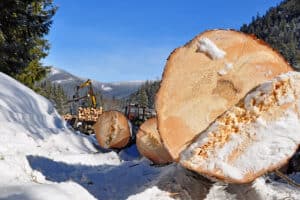This article includes notes from Dr. Mendell’s “Accounting for Inflation in Timber Forecasts” presentation in Portland at the 2013 “Who Will Own the Forest?” conference.
Introduction to Inflation
In 1913, one dollar bought 18 loaves of bread or three gallons of milk or close to three dozen eggs. Today, one hundred years later, one dollar fails to buy a single loaf of bread or gallon of milk. It buys about six eggs. This general increase in nominal prices, and associated decrease in real buying power, is inflation in action.
While inflation is a logical outcome of the money supply expanding faster than real growth, other factors apply. Research on average food prices over time by Jonathan Church and Ken Stewart at the U.S. Bureau of Labor Statistics demonstrates how consumer preferences and technology also influence prices. For example, the price of bread increased 25 times between 1913 and 2013. This tracks CPI – the Consumer Price Index – perfectly. Alternately, egg prices increased just 5 times, as advances in production, delivery, and storage techniques outpaced those seen for most other food items tracked by BLS. So on a relative basis, eggs got cheaper.
Inflation and Forecasting Timber Prices
At times, when developing timber forecasts or reviewing timberland valuation models, we find that inflation is misunderstood. A single rising price of a single product or commodity is not inflation. Sawmills are making more money this year because lumber prices are higher than last year, not because of inflation, which tracks the overall price level. And yet, the real, relative costs and revenues affecting timberland investments and wood-using facilities do change over time at different rates and times. While cash flow estimates used to value potential investments include projections of future prices, we find honest confusion and common mistakes continue to plague the use of real and nominal rates and prices.
In developing timber forecasts in the U.S., we recommend quantifying historic relationships using nominal (stated) prices that include inflation, and then adjusting for inflation if necessary. Why? Because the basis of market clearing transactions and real-time negotiations between wood buyers and timber sellers at any point are the prices as known and stated at that time in each and every local timber market given the known and available supplies and technology. As noted by timberland appraiser Jeff Wikle, “Yesterday’s (timber) price is based on yesterday’s technology.” Based on our understanding of forestry markets, this is exactly correct.
Once a price series has been forecasted, we can account for inflation (deflate prices), by dividing the series by a price index such as the Producer Price Index (PPI) or CPI. Which is better for deflating prices from timber forecasts: CPI or PPI? CPI highlights price changes over time for consumers, while PPI tracks changes in selling prices received by domestic firms providing goods and services. Typically, we use PPI, or a sub-series of PPI specific to relevant wood and forest products, because the growing and selling of timber or the manufacturing and selling of wood products represent, for the most part, business-to-business transactions.
Implications for Timberland Returns
Does this guidance require investors to deflate nominal returns using PPI when evaluating their investment portfolios? No. The context of the analysis matters. In the case of investors, using CPI provides a logical and consistent approach to compare the value-to-the-investor of the real returns over time. However, when evaluating the costs and revenues “under the hood” of any given investment, we want to get as close as possible to the actual, real, relative values of these cash inflows and outflows over time to evaluate the critical value drivers. Otherwise, we fail to account for the relative role of technology, in particular, and supply-to-demand relationships over time.
This content may not be used or reproduced in any manner whatsoever, in part or in whole, without written permission of LANDTHINK. Use of this content without permission is a violation of federal copyright law. The articles, posts, comments, opinions and information provided by LANDTHINK are for informational and research purposes only and DOES NOT substitute or coincide with the advice of an attorney, accountant, real estate broker or any other licensed real estate professional. LANDTHINK strongly advises visitors and readers to seek their own professional guidance and advice related to buying, investing in or selling real estate.









Today a dollar gets you a gallon of milk??? Are you milking that cow yourself? Here in Georgia, a dollar might buy you a 1/3 of a gallon!
Didn’t it say that a dollar used to get that price? I pay $3.50 at the farm.
I have KY timberland for sale with 3 pastures surrounding it which brings income to pay taxes. Anyone interested? 574-825-2421
It says a dollar “fails to buy a single loaf of bread or gallon of milk…”